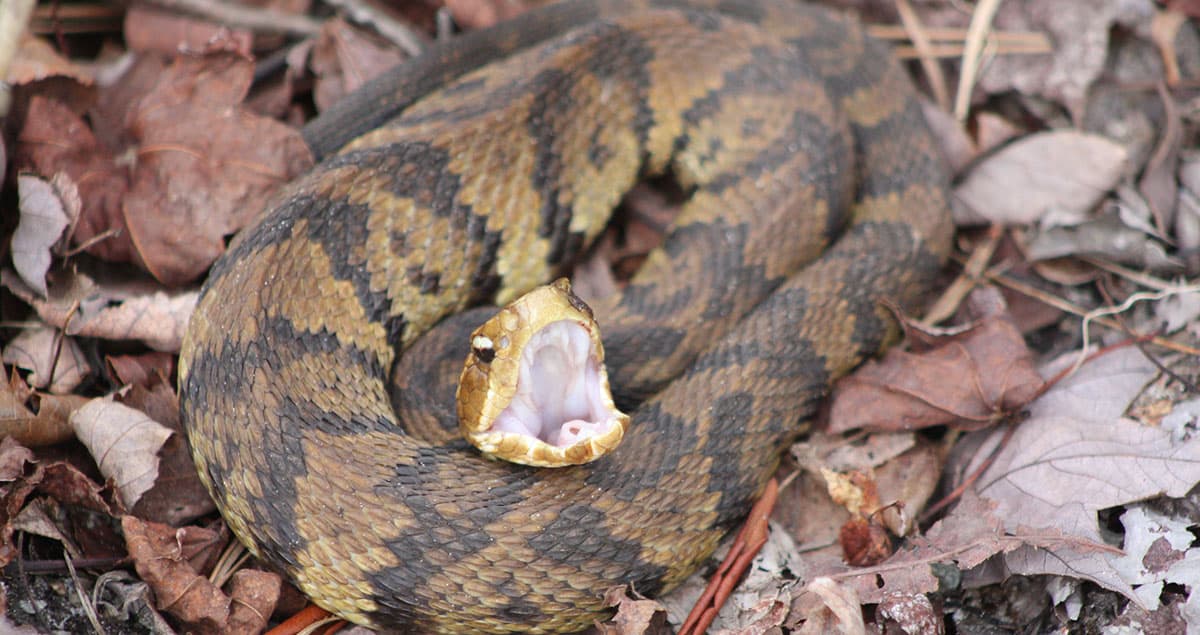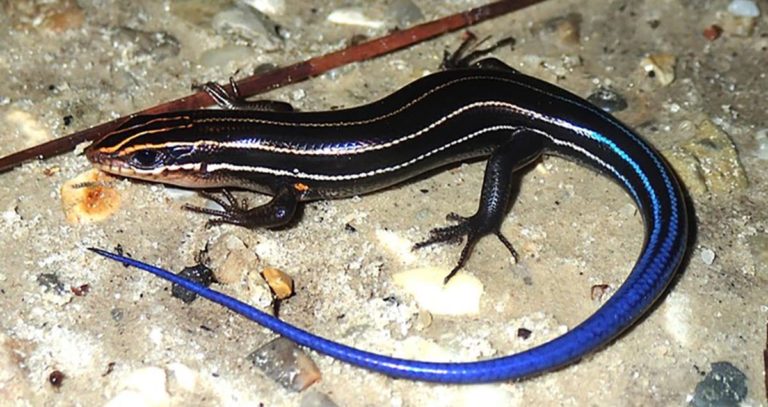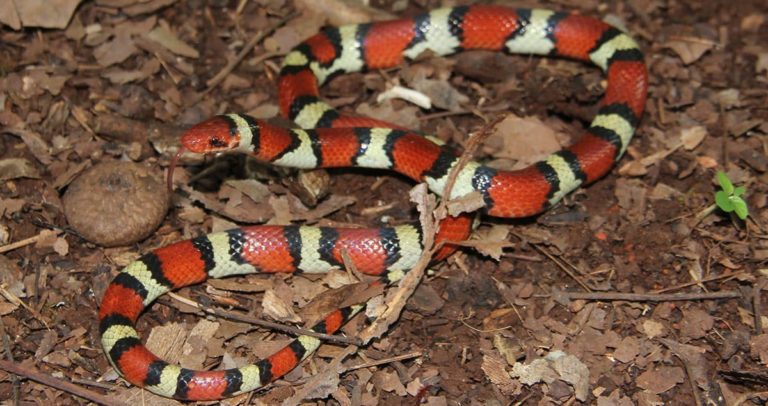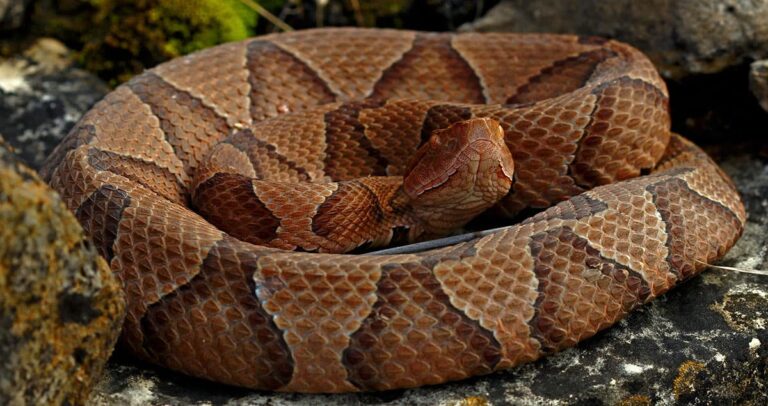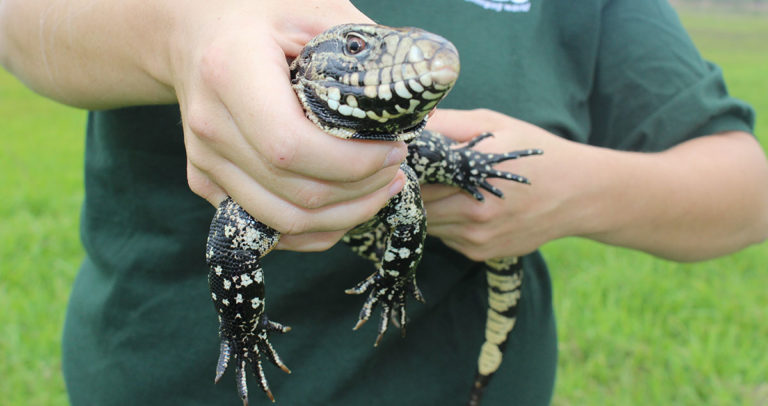Georgia’s Water Snake Species: Identifying Cottonmouths and Their Non-Venomous Look-Alikes
Georgia is home to a variety of water snake species, including the venomous cottonmouth (also known as the water moccasin) and several non-venomous species that are often mistaken for their venomous counterpart. In this guide, we’ll explore Georgia’s water snake species in detail and highlight the differences between the cottonmouth and non-venomous look-alikes.
Venomous Water Snake in Georgia
Cottonmouth (Agkistrodon piscivorus)
The cottonmouth is the only venomous water snake found in Georgia. It is a heavy-bodied snake with a thick, dark, and stout appearance. Its name comes from the white, cotton-like lining of its mouth, which it displays when threatened. Cottonmouths are usually found near water sources, such as swamps, rivers, and ponds. They have distinctive features that set them apart from non-venomous water snakes:
- A broad, triangular head with a noticeable neck
- Vertical, slit-like pupils
- Dark crossbands on their back, which may be faint or difficult to see on older individuals
- Keeled scales, giving them a rough-textured appearance
- A heat-sensitive pit between the eye and nostril on each side of the head
Non-Venomous Water Snakes in Georgia
Northern Water Snake (Nerodia sipedon)
Northern water snakes are one of the most commonly mistaken species for cottonmouths in Georgia. They are found in various aquatic habitats, including ponds, lakes, rivers, and streams. Key features to differentiate them from cottonmouths include:
- Narrower head and less noticeable neck
- Round pupils
- Dark crossbands that are narrower and less distinct than those of cottonmouths
- Scales that are not keeled, giving them a smooth appearance
Banded Water Snake (Nerodia fasciata)
The banded water snake is another non-venomous species that shares some similarities with the cottonmouth. It is typically found in slow-moving water bodies, such as swamps and marshes. Key distinguishing features include:
- Narrower head and less noticeable neck
- Round pupils
- Dark bands that are broader than those of cottonmouths, with a lighter background color
- Scales that are keeled, but the overall shape and pattern differ from cottonmouths
Brown Water Snake (Nerodia taxispilota)
The brown water snake is a non-venomous species native to Georgia, often found in heavily vegetated aquatic habitats. Its distinctive features include:
- A head that appears more elongated and less triangular than the cottonmouth
- Round pupils
- Dark, squarish blotches on a light brown or grayish-brown background color
- Scales that are keeled, but the overall shape and pattern differ from cottonmouths
Green Water Snake (Nerodia cyclopion)
The green water snake is a non-venomous species found in swampy, vegetated areas in Georgia. It can be differentiated from cottonmouths by its unique coloration and pattern:
- Narrower head and less noticeable neck
- Round pupils
- Uniform greenish or olive color, without the distinct bands or blotches seen in cottonmouths
- Scales that are keeled, but the overall appearance is different from cottonmouths
Midland Water Snake (Nerodia sipedon pleuralis)
The Midland water snake is a subspecies of the Northern water snake (Nerodia sipedon) found in Georgia. It inhabits ponds, lakes, rivers, and streams. The Midland water snake has the following features:
- Narrower head and less noticeable neck
- Round pupils
- Dark bands or blotches along the back with alternating bands on the sides
- Scales that are not keeled, giving them a smooth appearance
Red-bellied Water Snake (Nerodia erythrogaster)
The Red-bellied water snake is a non-venomous water snake found in Georgia. They are commonly found in slow-moving water bodies and heavily vegetated aquatic habitats. Distinguishing features include:
- Narrower head and less noticeable neck
- Round pupils
- Dark, square or rectangular blotches along the back, with a reddish or orange belly
- Keeled scales
Striped Crayfish Snake (Liodytes alleni)
The Striped Crayfish snake is a small, non-venomous water snake native to Georgia. It prefers wetland habitats and primarily feeds on crayfish. Key identifying features include:
- Small, slender body with a narrow head
- Round pupils
- Two light-colored stripes running down the length of the back
- Smooth scales
Glossy Crayfish Snake (Liodytes rigida)
The Glossy Crayfish snake is another small, non-venomous water snake found in Georgia. It inhabits wetlands and feeds on crayfish. Identifying features of the Glossy Crayfish snake include:
- Small, slender body with a narrow head
- Round pupils
- Dark brown to black coloration with a glossy sheen
- Smooth scales
Tips for Differentiating Georgia’s Water Snakes
- Examine the head and neck: Cottonmouths have a broad, triangular head and a noticeable neck, while non-venomous water snakes have a narrower head and less defined neck. Keep in mind that non-venomous snakes may flatten their heads when threatened, mimicking a venomous snake’s head shape.
- Check the pupils: Cottonmouths have vertical, slit-like pupils, while non-venomous water snakes have round pupils. However, be cautious when attempting to observe a snake’s pupils, as getting too close can be dangerous.
- Look for the heat-sensitive pit: Cottonmouths have a heat-sensitive pit between the eye and nostril on each side of the head, while non-venomous water snakes lack this feature.
- Observe the pattern and coloration: Cottonmouths have dark crossbands that may be faint or difficult to see on older individuals, while non-venomous water snakes have different patterns and colorations.
- Inspect the scales: Cottonmouths have keeled scales that give them a rough-textured appearance, while some non-venomous water snakes have smooth scales or keeled scales with different patterns.
Importance of Accurate Identification and Snake Conservation
Accurately identifying Georgia’s water snake species is essential for human safety and snake conservation. Knowing the differences between venomous and non-venomous species helps ensure that people can take appropriate precautions around potentially dangerous snakes. Additionally, it prevents the unnecessary killing of non-venomous snakes, which play an essential role in maintaining balanced ecosystems.
All snakes, venomous and non-venomous, contribute to the health of Georgia’s ecosystems. By learning more about the water snake species in the state and understanding how to differentiate them, we can work together to promote their conservation and protect their habitats.
Final Thoughts
Georgia’s water snake species include the venomous cottonmouth and several non-venomous species that are often mistaken for their dangerous counterpart. Understanding the differences between these snakes is crucial for both human safety and the conservation of these essential reptiles. By familiarizing ourselves with the distinctive features of each species, we can promote the well being of Georgia’s diverse ecosystems and the fascinating creatures that inhabit them.

